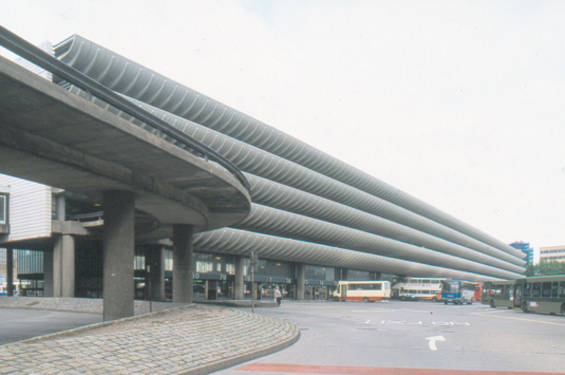This website uses cookies
This website uses cookies to enable it to function properly and to analyse how the website is used. Please click 'Close' to accept and continue using the website.



Claimed to be the largest building of its kind in Britain upon its completion in 1969 and recently called a ‘baroque cathedral for buses’, Preston Bus Station is certainly the largest building ever designed by Keith Ingham – working at the time for the Lancashire office of Building Design Partnership. The recipient of numerous awards, including ten Civic Trust awards or commendations and the RIBA Ideal Home House competition in 1962, Ingham’s dedication to the public cause of architecture led him – amidst numerous other activities – to set up a North West group for our Society (then The Thirties Society).
The bus station was designed to accommodate 80 double decker buses and 1,100 cars. To meet such a challenging brief, both in terms of dimensions and roughness of usage, a megastructure was proposed. Above its tall ground floor that accommodates all bus station facilities, the multi-storey car park expands on a split-level design of four and five decks. In continuous use ever since it first opened, four decades later, the building remains today virtually unaltered.
The bold forms of the car park floor parapets indisputably constitute the most striking and memorable expression of the strongly architectural effect of Preston Bus Station. In addition, the sculptural effect of the car park access ramps, the variety in use of materials and detailing of their finishes, along with the application of a coherent modular grid, bind together all construction elements – from glazing to the main structural skeleton – and further contribute to a lucidly articulated and fully coherent composition.
The design was markedly inspired by Paul Rudolph’s renowned design for a car park in New Haven, Connecticut, and elements of the latter’s design are reflected in Ingham’s particular emphasis on the horizontality and length of the car decks; his adoption of the economical split-level plan design; and certainly the celebration of the plasticity of his main material, concrete, although in this respect markedly distinguished from Rudolph’s board-marked concrete. The overall result is a building of clear architectural integrity whose assertive presence makes a positive contribution to its immediate townscape.
Despite long-running pressure to have it demolished, and inclusion of an image of it in Martin Parr’s Boring Postcards (actually quite a compliment surely?), Preston Bus Station holds a special place in the hearts of the local population. A poll conducted by a local newspaper (Lancashire Evening Post, 15 August 2000) revealed that a majority of 57% of readers wanted the building to be given listed status. At present, groups in online social networks have been formed to express support for the building. We hope the Society’s recent listing application will help safeguard this pivotal post-war monument for future generations.
Christina Malathouni

Become a C20 member today and help save our modern design heritage.